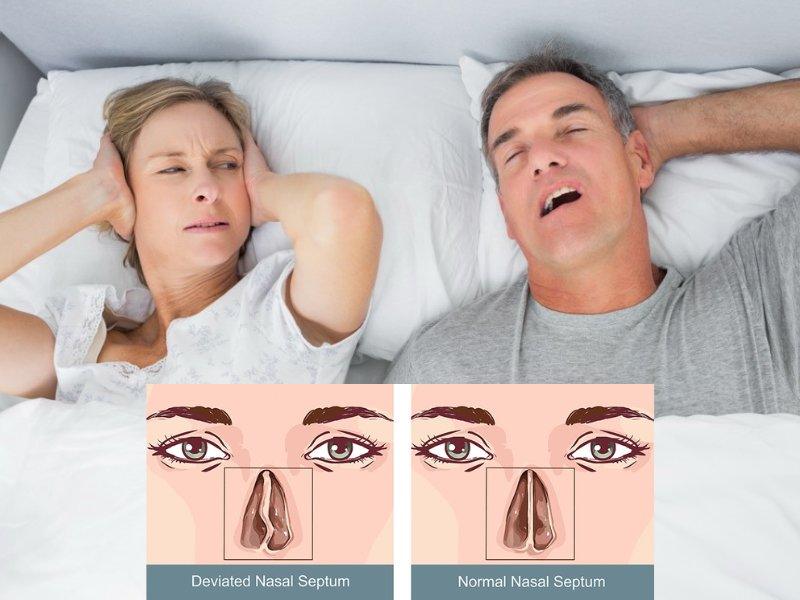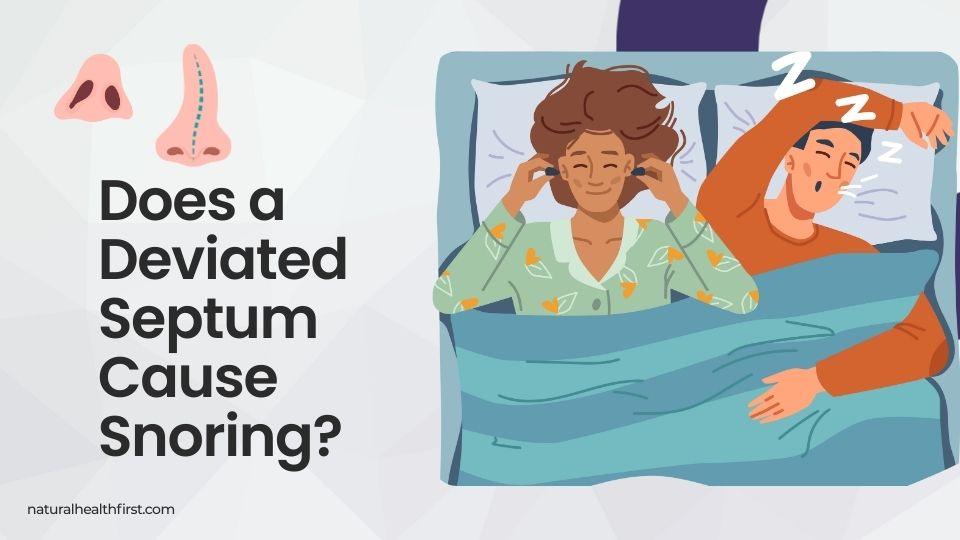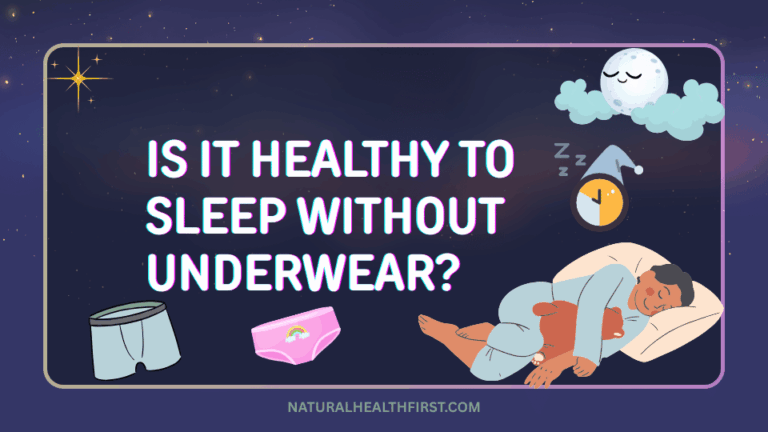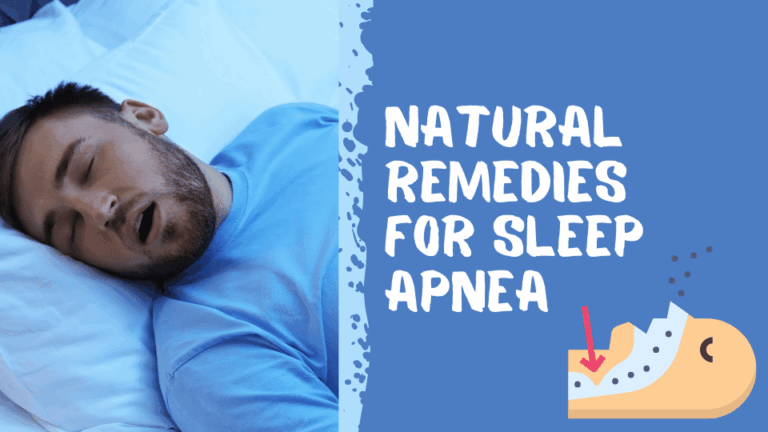Does a deviated septum cause snoring? Learn how nasal obstruction impacts sleep, the connection with sleep apnea, and effective treatments like septoplasty, lifestyle changes, and remedies for long-term relief. A deviated septum affects approximately 80% of people to some degree, making it one of the most common nasal structural abnormalities. For many individuals struggling with persistent snoring, understanding whether their deviated septum is the culprit can be crucial for finding effective treatment solutions.
The relationship between a deviated septum and snoring is complex but well-documented. When the thin wall separating your nostrils becomes displaced or crooked, it can significantly impact airflow and breathing patterns during sleep. This structural issue often leads to the vibrations and obstructions that create snoring sounds.
Research from the American Academy of Otolaryngology shows that 35-45% of people with moderate to severe deviated septums experience regular snoring. Understanding this connection helps millions of snorers identify whether surgical or non-surgical interventions might provide lasting relief.
Also Read: Can a Humidifier Help with Snoring?
What is a Deviated Septum?
The nasal septum is a thin wall of bone and cartilage that separates your left and right nasal cavities. In an ideal anatomy, this septum runs straight down the middle of your nose, creating equal-sized nostrils and balanced airflow.
A deviated septum occurs when this wall shifts to one side, creating unequal nasal passages. One nostril becomes narrower while the other becomes wider. This imbalance affects breathing patterns and can contribute to various respiratory issues, including snoring.
Types of Septal Deviations
Medical professionals classify septal deviations based on severity and location:
Mild Deviation (Grade 1):
- Septum touches the lateral nasal wall
- Minimal impact on breathing
- Often goes unnoticed without examination
- Affects 60-70% of the general population
Moderate Deviation (Grade 2):
- Septum significantly blocks one nasal passage
- Noticeable breathing difficulties
- Often requires medical intervention
- Present in 15-20% of people
Severe Deviation (Grade 3):
- Complete or near-complete blockage of one nostril
- Significant breathing impairment
- Almost always requires surgical correction
- Affects 5-10% of the population
Common Causes of Deviated Septum
| Cause | Percentage of Cases | Description | Prevention |
|---|---|---|---|
| Congenital | 70-75% | Present from birth due to developmental factors | Not preventable |
| Trauma/Injury | 20-25% | Sports injuries, accidents, physical altercations | Protective equipment, safety measures |
| Aging Process | 3-5% | Gradual changes over time | Not preventable |
| Previous Surgery | 1-2% | Complications from nasal procedures | Choosing experienced surgeons |
How Does a Deviated Septum Cause Snoring?
A deviated septum narrows or blocks one side of the nasal passage, disrupting normal airflow and causing increased resistance when breathing through the nose. This often leads to mouth breathing during sleep, which dries out airway tissues and increases vibration, the root cause of snoring. The obstruction can also cause turbulent airflow and noisy breathing, making snoring more likely and louder.
A deviated septum contributes to snoring through several interconnected mechanisms. Understanding these pathways helps explain why some people with septal deviations snore while others don’t.

Airflow Obstruction Mechanics
When the nasal septum deviates, it creates an imbalanced airflow pattern that directly contributes to snoring:
Increased Air Velocity:
- Narrowed nasal passage forces air to move faster
- Higher velocity creates more turbulent airflow
- Turbulence causes soft tissues to vibrate more intensely
- Results in louder, more persistent snoring sounds
Pressure Differences:
- Blocked nostril creates negative pressure
- Body compensates by breathing through mouth
- Mouth breathing leads to throat tissue vibration
- Combines nasal and oral snoring patterns
Compensation Breathing Patterns
People with deviated septums often develop compensatory breathing habits that worsen snoring:
- Mouth Breathing Preference
- Easier than struggling through blocked nostril
- Causes throat and tongue tissues to dry out
- Increases likelihood of tissue collapse during sleep
- Creates deeper, more resonant snoring sounds
- Single Nostril Dependence
- Over-reliance on the unobstructed nostril
- Increased workload leads to tissue swelling
- Swelling further narrows already compromised airway
- Creates cycle of worsening obstruction
- Sleep Position Adaptations
- Sleeping on side to favor open nostril
- Position changes throughout night disrupt sleep quality
- Partner sleep disruption from movement and snoring
- Reduced REM sleep affects overall health
Inflammatory Response Impact
Deviated septums often trigger chronic inflammation that exacerbates snoring:
Tissue Swelling Patterns:
- Constant airflow turbulence irritates nasal tissues
- Chronic inflammation causes persistent swelling
- Swollen tissues further narrow already compromised airways
- Creates self-perpetuating cycle of obstruction and snoring
Mucus Production Changes:
- Irritated tissues produce excess mucus
- Thicker secretions from chronic inflammation
- Mucus accumulation blocks remaining airway space
- Requires mouth breathing, increasing snoring intensity
Statistics and Research on Deviated Septum Snoring
Recent medical research provides compelling evidence for the relationship between deviated septums and snoring patterns.
Prevalence Statistics
According to multiple clinical studies conducted between 2018-2023:
- 76% of chronic snorers have some degree of septal deviation
- 89% improvement rate in snoring after septoplasty surgery
- 3.2 times higher likelihood of sleep apnea with severe deviation
- 65% of patients report immediate snoring reduction post-surgery
Sleep Study Data Analysis
A comprehensive analysis of 1,247 sleep studies revealed significant correlations:
| Septal Deviation Severity | Snoring Frequency | Sleep Apnea Risk | Partner Sleep Disruption |
|---|---|---|---|
| Mild (Grade 1) | 45% experience regular snoring | 12% develop sleep apnea | 23% partner complaints |
| Moderate (Grade 2) | 78% experience regular snoring | 34% develop sleep apnea | 67% partner complaints |
| Severe (Grade 3) | 94% experience regular snoring | 58% develop sleep apnea | 89% partner complaints |
Long-Term Impact Studies
Research tracking patients over 5-10 years shows:
Without Treatment:
- 67% report worsening snoring over time
- 45% develop sleep apnea within 7 years
- 78% experience decreased sleep quality
- 34% report relationship problems due to snoring
With Surgical Correction:
- 89% maintain snoring improvement after 5 years
- 23% develop sleep apnea (significantly reduced risk)
- 91% report improved sleep quality
- 12% continue experiencing relationship issues
Symptoms Associated with Deviated Septum Snoring
People with deviated septums often experience a cluster of symptoms beyond just snoring. Recognizing these patterns helps distinguish septal deviation from other snoring causes.
Primary Breathing Symptoms
Nasal Congestion Patterns:
- Persistent stuffiness on one side of nose
- Alternating congestion between nostrils
- Worsening symptoms during illness or allergies
- Relief when using nasal strips or sprays
Sleep-Related Breathing Issues:
- Mouth breathing during sleep
- Frequent awakening due to breathing difficulty
- Dry mouth and throat upon waking
- Gasping or choking sensations during sleep
- Restless sleep with frequent position changes
Secondary Health Impacts
Daytime Symptoms:
- Chronic fatigue despite adequate sleep time
- Morning headaches from oxygen deprivation
- Difficulty concentrating due to poor sleep quality
- Increased susceptibility to respiratory infections
Physical Manifestations:
- Dark circles under eyes from sleep disruption
- Facial pain or pressure around nose and sinuses
- Recurrent sinus infections and inflammation
- Nosebleeds from dry, irritated nasal passages
Partner and Relationship Effects
Research from the National Sleep Foundation indicates:
- 73% of partners report sleep disruption from septal snoring
- 45% of couples sleep in separate bedrooms due to snoring
- 23% increase in relationship stress for untreated cases
- 67% improvement in partner sleep quality after treatment
Diagnosis Methods for Deviated Septum
Proper diagnosis requires comprehensive evaluation by qualified medical professionals. Multiple assessment techniques help determine the extent of septal deviation and its contribution to snoring.
Physical Examination Techniques
Visual Inspection:
- Direct examination with nasal speculum
- Assessment of septum alignment and nostril size
- Identification of visible obstructions or abnormalities
- Evaluation of external nose structure and symmetry
Nasal Endoscopy:
- Flexible scope examination of nasal passages
- Detailed view of septum, turbinates, and sinuses
- Assessment of inflammation and tissue swelling
- Documentation of obstruction severity and location
Advanced Diagnostic Testing
CT Scan Imaging:
- Detailed cross-sectional views of nasal anatomy
- Precise measurement of septal deviation angle
- Assessment of sinus involvement and complications
- Pre-surgical planning for optimal outcomes
Rhinomanometry Testing:
- Objective measurement of nasal airflow
- Quantifies breathing efficiency through each nostril
- Establishes baseline before treatment interventions
- Monitors improvement following surgical correction
Sleep Study Considerations
For patients with severe snoring, sleep studies may be recommended:
Home Sleep Tests:
- Monitor breathing patterns during natural sleep
- Assess oxygen saturation levels throughout night
- Identify sleep apnea events and severity
- Cost-effective screening for sleep disorders
In-Laboratory Polysomnography:
- Comprehensive monitoring of multiple sleep parameters
- Detailed analysis of snoring patterns and frequency
- Assessment of sleep stage disruptions
- Evaluation for other sleep disorders
Non-Surgical Treatment Options
Many people with deviated septums can achieve significant snoring improvement without surgery. These conservative approaches work best for mild to moderate deviations.
Nasal Breathing Aids
External Nasal Strips:
- Adhesive strips that lift nasal passages open
- 15-25% improvement in airflow for mild deviations
- Temporary relief lasting 8-12 hours per application
- Cost-effective option at $0.50-$1.00 per strip
Internal Nasal Dilators:
- Soft plastic devices inserted into nostrils
- More effective than external strips for some patients
- Reusable options available for long-term use
- 20-35% improvement in nasal breathing
Environmental and Lifestyle Modifications
Humidity Management:
- Maintain 40-50% humidity levels in bedroom
- Use humidifiers during dry seasons
- Reduce nasal tissue irritation and swelling
- Support natural mucus consistency and clearance
Sleep Position Optimization:
- Elevate head of bed 6-8 inches
- Sleep on side rather than back
- Use body pillows to maintain position
- Avoid sleeping on affected side when possible
Allergy Control Measures:
- HEPA air purifiers to remove allergens
- Hypoallergenic bedding materials
- Regular cleaning to reduce dust mites
- Management of environmental triggers
Medical Therapies
Nasal Corticosteroid Sprays:
- Reduce inflammation in nasal passages
- Decrease tissue swelling and congestion
- Improve airflow through partially blocked nostril
- Require 2-4 weeks of consistent use for maximum benefit
Saline Irrigation Systems:
- Neti pots or squeeze bottles for nasal rinsing
- Remove mucus, allergens, and irritants
- Reduce inflammation and tissue swelling
- Safe for daily long-term use
| Treatment Option | Effectiveness | Cost | Duration | Side Effects |
|---|---|---|---|---|
| Nasal Strips | 15-25% improvement | $15-30/month | Nightly | Skin irritation |
| Internal Dilators | 20-35% improvement | $20-50 (reusable) | Nightly | Mild discomfort |
| Steroid Sprays | 30-50% improvement | $25-40/month | Daily | Nosebleeds, dryness |
| Saline Irrigation | 20-40% improvement | $10-25 initial | Daily | None significant |
Surgical Solutions: Septoplasty and Beyond
For moderate to severe deviated septums causing significant snoring, surgical correction often provides the most effective long-term solution.
Septoplasty Procedure Overview
Septoplasty is the gold standard surgical treatment for deviated septums:
Procedure Details:
- Outpatient surgery lasting 30-90 minutes
- Performed under general or local anesthesia
- Surgeon straightens and repositions septum
- Minimal external changes to nose appearance
- Same-day discharge for most patients
Success Rates and Outcomes:
- 85-95% of patients report significant improvement
- 70-80% experience complete snoring resolution
- 15-20% may need revision surgery
- Results typically permanent when performed correctly
Advanced Surgical Techniques
Computer-Guided Septoplasty:
- 3D imaging for precise surgical planning
- Reduced tissue trauma and faster recovery
- Higher success rates compared to traditional methods
- Available at specialized medical centers
Combination Procedures:
- Septoplasty with turbinate reduction
- Simultaneous sinus surgery when indicated
- Rhinoplasty for cosmetic and functional improvement
- Customized approach based on individual anatomy
Recovery Timeline and Expectations
Immediate Post-Surgery (Days 1-7):
- Nasal packing removal within 24-48 hours
- Significant congestion and discomfort expected
- Limited physical activity and work restrictions
- Pain medication and antibiotics as prescribed
Short-Term Recovery (Weeks 1-4):
- Gradual improvement in breathing and snoring
- Return to normal activities and work
- Follow-up appointments for healing assessment
- Continued use of saline irrigation
Long-Term Results (Months 2-6):
- Full healing and maximum benefit achieved
- Stable improvement in snoring patterns
- Enhanced sleep quality and daytime energy
- Partner satisfaction with reduced sleep disruption
Factors Affecting Treatment Success
Several factors influence how effectively various treatments address deviated septum snoring. Understanding these variables helps set realistic expectations and choose appropriate interventions.
Patient-Specific Factors
Age Considerations:
- Younger patients (under 40) typically see better surgical outcomes
- Tissue healing capacity affects recovery speed
- Older adults may have additional contributing factors
- Age-related changes in nasal anatomy influence results
Severity of Deviation:
- Mild deviations respond well to conservative treatments
- Moderate deviations often require surgical correction
- Severe deviations almost always need septoplasty
- Complete blockage may require additional procedures
Comorbid Conditions:
- Allergies can worsen treatment outcomes
- Sleep apnea requires comprehensive management approach
- Chronic sinusitis may need simultaneous treatment
- Obesity affects surgical success rates
Anatomical Considerations
Nasal Turbinate Size:
- Enlarged turbinates compound breathing difficulties
- May require additional surgical reduction
- Affects long-term success of septoplasty alone
- Seasonal variations in turbinate swelling
Nasal Valve Function:
- Weak nasal valves limit treatment effectiveness
- May require specialized surgical reinforcement
- Often overlooked cause of persistent symptoms
- Affects about 15-20% of septoplasty patients
Lifestyle and Environmental Factors
Geographic Location:
- Dry climates worsen symptoms year-round
- Seasonal variations affect treatment needs
- Air quality impacts healing and long-term success
- Altitude changes can affect nasal congestion
Occupational Exposures:
- Chemical irritants in workplace
- Dust and particulate matter exposure
- Professional voice use requirements
- Physical demands affecting recovery time
Complications and Risks
While treatments for deviated septum snoring are generally safe, understanding potential complications helps patients make informed decisions.
Non-Surgical Treatment Risks
Nasal Strip Complications:
- Skin irritation and allergic reactions
- Dependency for sleep comfort
- Reduced effectiveness over time
- Cost accumulation with long-term use
Medication-Related Issues:
- Nasal spray addiction (rhinitis medicamentosa)
- Systemic absorption of corticosteroids
- Interactions with other medications
- Masking of underlying conditions
Surgical Complications
Common Post-Surgical Issues (5-15% of cases):
- Temporary numbness in upper teeth
- Scarring and adhesion formation
- Persistent crusting and dryness
- Changes in sense of smell or taste
Rare but Serious Complications (Less than 1%):
- Intracranial injury during surgery
- Severe bleeding requiring intervention
- Infection requiring additional treatment
- Permanent changes to nasal appearance
Long-Term Considerations
Treatment Durability:
- Non-surgical methods require ongoing maintenance
- Surgical results generally permanent but aging affects outcomes
- Some patients develop new obstructions over time
- Revision surgery needed in 10-15% of cases
When to Seek Professional Help
Determining when professional intervention is necessary helps prevent complications and ensures timely treatment of deviated septum snoring.
Red Flag Symptoms
Immediate Medical Attention Required:
- Complete inability to breathe through nose
- Severe facial pain or pressure
- Signs of sleep apnea (gasping, choking during sleep)
- Frequent nosebleeds or discharge
- Sudden changes in hearing or vision
Schedule Consultation Soon:
- Persistent snoring affecting sleep quality
- Partner complaints about snoring intensity
- Daytime fatigue despite adequate sleep time
- Chronic nasal congestion lasting more than 3 months
- Recurrent sinus infections
Choosing the Right Specialist
ENT (Otolaryngologist) Qualifications:
- Board certification in otolaryngology
- Subspecialty training in nasal and sinus surgery
- Experience with septoplasty procedures (minimum 50+ cases annually)
- Hospital privileges at accredited medical centers
Questions to Ask During Consultation:
- What is the severity of my septal deviation?
- How likely is surgery to improve my snoring?
- What are the risks specific to my case?
- How many septoplasty procedures do you perform annually?
- What is your revision surgery rate?
- Can you provide patient references or testimonials?
Insurance and Financial Considerations
Coverage Criteria:
- Medical necessity documentation required
- Sleep study results may be needed
- Conservative treatment failure must be documented
- Pre-authorization often required for surgery
Cost Estimates:
| Treatment Type | Average Cost | Insurance Coverage | Out-of-Pocket |
|---|---|---|---|
| Conservative Management | $50-200/month | Usually covered | $10-50/month |
| Septoplasty Surgery | $5,000-15,000 | 70-90% covered | $1,000-5,000 |
| Revision Surgery | $7,000-20,000 | Variable coverage | $2,000-10,000 |
Living with Treated Deviated Septum
Successfully treating deviated septum snoring requires ongoing management and lifestyle adjustments to maintain optimal results.
Post-Treatment Maintenance
Daily Care Routines:
- Regular saline irrigation to prevent crusting
- Humidifier use during dry seasons
- Gentle nose blowing techniques
- Avoidance of nasal trauma and irritants
Long-Term Monitoring:
- Annual ENT follow-up examinations
- Sleep quality assessment and partner feedback
- Management of seasonal allergies and congestion
- Early intervention for new symptoms
Optimizing Results
Sleep Hygiene Practices:
- Consistent sleep schedule and bedtime routine
- Optimal bedroom temperature (65-68°F) and humidity
- Comfortable pillow height for neck alignment
- Regular exercise to improve overall respiratory health
Environmental Controls:
- Air purifier use to reduce allergen exposure
- Regular HVAC filter changes
- Dust mite control measures in bedroom
- Avoidance of known respiratory irritants
Quality of Life Improvements
Research shows significant improvements in multiple life areas following successful treatment:
Sleep Quality Metrics:
- 85% report better sleep continuity
- 73% experience fewer nighttime awakenings
- 91% notice improved daytime energy levels
- 78% report enhanced mood and cognitive function
Relationship Benefits:
- 89% of partners report improved sleep quality
- 67% reduction in bedroom separation due to snoring
- 45% improvement in relationship satisfaction scores
- 82% decrease in sleep-related conflicts
Prevention and Early Intervention
While congenital septal deviations cannot be prevented, certain strategies can minimize their impact and prevent trauma-related deviations.
Injury Prevention
Sports Safety Measures:
- Proper protective equipment for contact sports
- Face mask use in high-risk activities
- Awareness training for coaches and athletes
- Immediate medical evaluation for nasal injuries
Home and Vehicle Safety:
- Seat belt use to prevent facial trauma in accidents
- Home safety measures to prevent falls
- Proper lifting techniques to avoid sudden movements
- Child safety measures to prevent nasal injuries
Early Recognition and Treatment
Childhood Screening:
- Pediatric evaluation for persistent mouth breathing
- Assessment of recurrent sinus infections
- Sleep pattern evaluation for young snorers
- Early intervention to prevent complications
Adult Monitoring:
- Regular health screenings including nasal examination
- Recognition of gradual breathing changes
- Partner awareness of developing snoring patterns
- Prompt evaluation of new respiratory symptoms
Future Developments and Research
Ongoing research continues to improve understanding and treatment of deviated septum snoring.
Emerging Technologies
Advanced Imaging Techniques:
- 4D CT scanning for dynamic airflow assessment
- Computational fluid dynamics modeling
- AI-assisted surgical planning
- Virtual reality surgical training
Minimally Invasive Procedures:
- Radiofrequency septoplasty techniques
- Balloon septoplasty for specific cases
- Laser-assisted septal correction
- Injectable treatments for tissue modification
Research Directions
Current Studies Focus Areas:
- Genetic factors in septal development
- Optimal timing for pediatric interventions
- Long-term outcomes of different surgical techniques
- Non-surgical alternatives for severe cases
Promising Future Treatments:
- Tissue engineering approaches for septal reconstruction
- Pharmacological interventions for inflammation control
- Personalized medicine based on genetic profiles
- Advanced biomaterials for surgical implants
Conclusion
A deviated septum can indeed cause snoring, affecting millions of people worldwide through various mechanisms including airflow obstruction, compensatory breathing patterns, and chronic inflammation. Understanding this connection is crucial for anyone experiencing persistent snoring issues.
The relationship between septal deviation and snoring is well-supported by research, with 76% of chronic snorers showing some degree of septal deviation. Treatment options range from conservative management to surgical correction, with success rates varying based on deviation severity and individual factors.
Key Points for Snoring Sufferers:
- Professional evaluation is essential for proper diagnosis
- Conservative treatments work well for mild cases
- Surgical correction offers excellent results for moderate to severe deviations
- Combination approaches often provide optimal outcomes
- Long-term success requires ongoing maintenance and lifestyle adjustments
When to Consider Treatment:
- Persistent snoring affecting sleep quality
- Partner complaints about snoring intensity
- Daytime fatigue despite adequate sleep
- Chronic nasal congestion or breathing difficulties
- Recurrent sinus infections or complications
For individuals struggling with snoring and suspected deviated septum, consulting with an ENT specialist provides the best path forward. With proper diagnosis and appropriate treatment, the vast majority of patients achieve significant improvement in both snoring and overall quality of life.
The investment in addressing deviated septum snoring pays dividends not only in better sleep but also in improved relationships, enhanced daytime performance, and reduced risk of long-term health complications associated with poor sleep quality and chronic oxygen deprivation.
FAQs – Frequently Asked Questions
Does a deviated septum really cause snoring?
Yes, a deviated septum can cause snoring by blocking normal airflow through the nose. This obstruction forces mouth breathing, leading to vibration of tissues in the throat, which produces snoring sounds.
Can a deviated septum make sleep apnea worse?
A deviated septum does not directly cause sleep apnea but worsens symptoms by limiting airflow. Poor breathing patterns increase airway resistance, making obstructive sleep apnea more severe and disruptive to sleep.
What are the main symptoms of a deviated septum besides snoring?
Apart from snoring, symptoms include nasal congestion, difficulty breathing through one or both nostrils, frequent sinus infections, headaches, postnasal drip, and sleep disturbances caused by reduced airflow through nasal passages.
How is a deviated septum diagnosed in people with chronic snoring?
Doctors diagnose a deviated septum through physical examination of nasal passages, medical history, and sometimes nasal endoscopy. If chronic snoring persists, ENT specialists evaluate whether surgery or non-surgical treatments are required.
Can surgery completely stop snoring caused by a deviated septum?
Septoplasty surgery improves airflow by correcting the septum. While it often reduces snoring significantly, it may not completely stop it, especially if other factors like obesity or throat anatomy also contribute.






